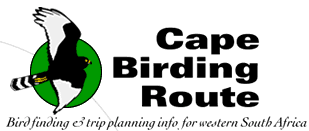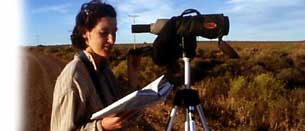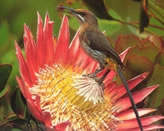Karoopoort
to Eierkop
Emerging
from the Koue Bokkeveld mountains and onto the semidesert
plains of the Tanqua Karoo, one soon reaches a fork in the
road (2 on map). In contrast with their unassuming appearance,
each of these roads is associated with a South African record:
the R356, to the right, leads to the town of Sutherland, which,
thanks to its crisp, pollution-free desert skies, is the site
of a world-class astronomical observatory. Rather less alluringly,
it is ill-famed as the coldest place in the country! To the
left is the R355 to Calvinia, similarly notorious as the longest
road in South Africa uninterrupted by a town (250 km in all).
The surface is of good quality gravel, but travellers driving
all the way to Calvinia should nonetheless come well prepared
with fuel and emergency water supplies — and should remember
to check their spare wheel (see also p.10). Birders should
be particularly aware that braking suddenly on these roads
could well result in a damaged tyre, as the gravel in this
region is iniquitously sharp.
Common
birds of the relatively moist scrublands just north of the
road fork are Pale Chanting Goshawk, Karoo Lark,
Karoo Chat, Yellow Canary and, more scarcely,
Sickle-winged Chat and Southern
Black Korhaan (p.57*). At 3, the road is crossed by
an acacia-lined rivercourse where Pririt Batis (p.85*)
and Titbabbler occur. You may notice the farm name
‘Tierkloof’ (see p. 8), referring to the Leopard
(Panthera pardus) that still roam this region, although
they are secretive and, sadly, now very scarce.
At
4 is a large dam, visible some distance to the east of the
road. More often than not, the water level is low and the
associated waterbirds are distant, reduced to amorphous shimmering
blobs in the telescope. Nonetheless, it is worth the 200-m
stroll down from the road to the farm fence to scan the water,
as the adjacent scrub is, in any case, always good for a number
of bird species. South African Shelduck and Greater
Flamingo are often present on the dam, and Namaqua
Sandgrouse occasion-ally fly in to drink. The dam is situated
on the game reserve Inverdoorn; please respect the fence —
there are rhino to enforce the law!
One
kilometre further on, at 5, there is a prominent sandy intrusion
on the landscape. A small group of Anteating Chats
is usu-ally present on these low, vegetated dunes. These most
peculiar birds nest in burrows, hence their association with
a soft substrate.
An
excellent spot to look for several key Karoo specials is the
distinctive pair of tillite hills straddling the road at 6.
An inconspicuous gravel track, easily negotiable by two-wheel-drive,
leads 500 m east from the R355 to the base of Eierkop, the
right-hand hill. Eierkop (‘egg-hill’) probably owes
its name to the tiny, smoothed pieces of ostrich egg shells
found on the summit; these were probably left by the early
San hunter-gatherers, whose paintings are found in nearby
rock shelters. Eierkop is arguably the most access-ible site
worldwide for Karoo
Eremomela (p.85*). A small party is more often than
not present on the plains surrounding this hill, moving quickly
and inconspicuously from bush to bush, usually keeping an
infuriat-ingly fixed distance ahead of their observers. Be
sure to stay alert to their two calls (see p.85). Other common
and typical birds of this habitat are Karoo Lark, Karoo
Chat, Rufous-eared Warbler and Grey-backed Cisticola.
The slightly denser scrub around the base of Eierkop supports
Southern Grey Tit, White-throated Canary, Malachite
Sunbird and, in spring during years of good rainfall,
Black-headed
Canary (p.105*) and Lark-like Bunting.
The
short scramble up to the top of Eierkop is well worth the
effort: the summit is bedecked with an intriguing diversity
of succulents, and provides stunning panoramic views over
the surrounding expanse of brown desert plains and shimmering
purple mountains.
|


